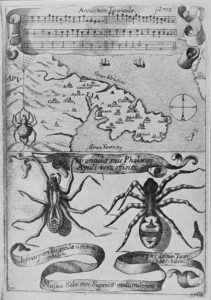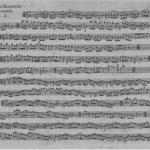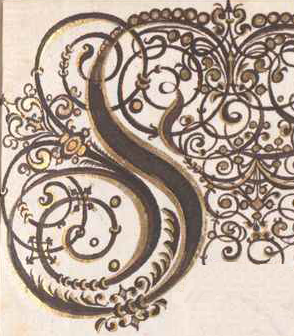Tarantella versions in the 17th and 18th century
The Tarantella has spoken to the imagination throughout time. In the 17th and 18th century we find examples of the actual music for the first time! In this post we are discussing all the versions we could find, including audio examples and sheet music for the basic patterns.
We also made a video series so you can learn to improvise on the Tarantella yourself! Click here.

Athanasius Kircher – Magnes, sive de arte magnetica (1641)
Athanasius Kircher was a Jesuit who travelled widely, ending up in Rome in Papal circles. One book refers to him as “The Last man who knew everything”. He wrote the biggest encyclopedia about music of his time and often combined fiction (for example a cat piano in which cat’s tails got pricked to make the tones) with fact.
However, his biggest discussion of Tarantism is in his book on magnetism (which was one of the few works not to be discredited after his death).
Kircher’s is the most extensive discussion of the music used for the Tarantella. In the following 150 years, each Tarantella we can find is based on or related to one of the types in Kircher’s book. One reason for this could also be that Kircher’s works were widely disseminated. His music encyclopedia was found back all over the world, from Latin America to China. His discussion of the Tarantella can be found back in the works of several scientists, among which Robert Boyle!
Interestingly, almost all versions are in duple meter, in other words in 4/4 or 2/2.
whereas nowadays we would mostly think of the tarantella as a dance in 6/8.
Kircher's Tarantellas
| Name | Type | Meter | Sound | Link |
|---|---|---|---|---|
| Primus Modus | A | C (4/4) | Primus modus (only till 0:22!) | Modern notation |
| Secundus Modus | A | C (4/4) | Secundus Modus from 0:22 | Modern notation |
| Tertius Modus | A | C (4/4) | From 0:37 | Modern notation |
| Tu pettu e fattu | Hypodorico | C (4/4) | (not exact same piece) | Modern notation |
| Antidotum Tarantulae | Antidotum (first half variation on type A) | cut C (2/2) | Spotify | Modern notation |
| Tarantella with ritornello | Hypodorico (missing out chord 2 and 3) | C (4/4) | midi version | Modern notation |
| Tono Hypodorico | Hypodorico | 3/2 | Spotify link | modern notation |
| Alia Clausula | Alia | C (4/4) | Slightly bizarre version | Modern notation |
Athanasius Kircher – Phonurgia Nova (1673)
About thirty years later, Kircher publishes a book on acoustics, and in it he talks about Tarantism again, printing another version of the Antidotum Tarantulae. Interestingly he does not include the other versions, AND this version doesn’t make any sense rhythmically. An attempt at transcription:
Antidotum_Tarantulae_Kircher variant in Phonurgia Nova
Cristofaro Caresana – Cantata La Tarantella
Caresana worked in Naples as a composer organist and singer from 1658 till 1709. His vocal tutors were influential and even reprinted for the Paris conservatoire in 1819! Naples was very close to some of the Tarantella capitals, so Caresana may have witnessed Tarantism with his own ear and eye.
There are two pieces by him that use the Tarantella. The first is a cantata:
After a bit of an introduction we get a Tarantella of the Hypodorico type (with an added bonus of a prolonged cadence at some points). Also interesting to note is that this Hypodorico type is in 4/4, whereas it is usually in 3. The entire piece can be found here on IMSLP in manuscript form.
Here I have “summarised” the basic form in modern notation. It is definitely worth looking at some of the melodic formulae Caresana uses over this bass though!
Caresana also used the Tarantella in an educational duo. I cannot find it online, Liuwe Tamminga arranged it here:
Gaspar Sanz – Instruccion de Musica (1674)
Gaspar Sanz was a Spanish guitarist, composer and priest. Interestingly, he studied with Caresana in Naples and quite possibly learned about the Tarantella there. His Instruccion de Musica was the most comprehensive guitar treatise of its time and many guitarists were inspired to publish similar collections.
This piece is of the Hypodorico type. It is realised solely in chords: there are some extra harmonic detours. More soon… .
Anonymous manuscript: piezas para clave c 1700 in the Madrid Royal Library
This version is based on a hybrid of the Antidotum and the Hypodorico type. It was widely circulated in a medical treatise by the Spaniard Don Francisco Xavier Cid. I therefore coined it the Cid type. Interestingly we also find the repetition of two chords, generally “I” and “V”, as in the Sanz version above.
Another typical part of the Cid type is that it is actually three tarantelle. This three-partite form was also already present in the Kircher Hypodorico type.
This is the earliest Tarantella in 6/8 that I could find.
PDF: Tarantella mss anonimo piezas para clave c 1700 bibl nac madrid
MIDI version:
Diego Fernandez de Huete – Compendio Numeroso de Zifras Armonicas (1702)
De Huete was a Spanish harpist, composer, theorist and teacher. The Oxford dictionary of music calls his Compendio Numeroso the climax of a golden age for the harp.
This version is also based on the hypodorico type in 3, sometimes there is a variation of the harmony on the 4th chord!
Santiago de Murcia – Resumen de accompañar la parte (1714) & Saldivar Codex n.4 (1720)
Santiago de Murcia was a Spanish guitar player, composer and theorist. He too was very influential, and on his part was clearly influenced by the earlier mentioned Instruccion de Musica by Gaspar Sanz.
Both the tarantelle in the Resumen as in the Saldivar are based on the hypodorico type. In the Resumen the piece is in 3, in the Saldivar Codex in 6/8. In the future we will talk about the different diminutions and formal qualities of these pieces.
Gaetano Greco (1700-1728?) – Tarantella
Gaetano Greco was a partimento teacher in Naples. In too few words: a partimento is a bass line, sometimes with numbers on top. The bass and these numbers ‘encode’ a possible piece of music and this method was used to teach composition, music, improvisation, etc. All of Greco’s Tarantella partimenti are based on the Hypodorico type in C, that is in 4/4.
We can find two unrealised partimenti (so only the bass part) amongst his teaching materials. Mostly partimenti are not this short; perhaps they are just a little practice for the longer Tarantella that comes later in the manuscript, or the different figurations suggest what one could do in a longer Tarantella improvisation?
There is also an “intavolatura”, a realised partimento. So this means, the melody is written out in notes. As many realisations were only done by the student with the teacher, and written versions of those are scarce, this is quite exciting! Beside the melody and the bass there are still numbers. This could suggest that one is still expected to fill in the middle parts. Great exercise! In the link below you will see this version in the fantastic book “The Art of Partimento” by Giorgo Sanguinetti:
Intavolatura of Gaetano Greco, Tarantella R 259.
Don Francisco Xavier Cid – Tarantella Italiana (1787)
Cid wrote a medical treatise in 1787 in which he described the most ‘cases’ that have been collected in any treatise so far. The book can be found here.
This type conflates several ideas, starting with the hypodorico type and then going on with the second part of the antidotum type.

Cid says there are three similar tarantelle. They are all in 6/8. All of them are based around these hypodorico and antidotum types and otherwise mostly use the alternation of two chords (tonic and dominant) as before in Sanz and the repetition of one and the same chord. Both these ideas are also used a lot in the Tarantelle we can hear nowadays.
In Liuwe Tamminga’s recording they are all played in one track. Interestingly one part seems to have been skipped. Also the harmony isn’t there originally, as far as I could see. It means that for the section in 12/8 (which is not on the recording) I made a bass line myself following as much as possible the earlier bass movements. But feel free to change it, comment on it, etc.!
Modern notation here, with a bass line from the recording below, and partly my own. N.B.: the bass line is also very similar to the anonymous version from Madrid, mentioned above.
Stephen Storace – Torre Annunziata
Also based on the Cid type. I’m not sure where the Tarantula Tune comes from. I think it must be from an opera. Stephen Storace’s father, Stefano Storace (not at all confusing) wrote an account of Tarantism in the Gentleman’s Magazine of 1753. Read Storace’s account here. In the version you can see here I transcribed the music from the Spotify track. Between brackets are two notes which would be more logical in terms of what would usually be there; I’m not sure whether these are in a score or that it is just the melody that was found by Tamminga &co.
La Carpinese
In the wonderful book 50 Standards of the Renaissance and Baroque by Pascale Boquet and Gérard Rebours, we find two pages of different versions of the Tarantella. They also include “Carpinese”. It is in 4 and I suppose it is related to the A type. The authors mention many of the above versions too, and write that La Carpinese is also in Kircher’s book Magnes sive de arte Magnetica. However, I couldn’t find it in Kircher’s book. I will include it nonetheless:
